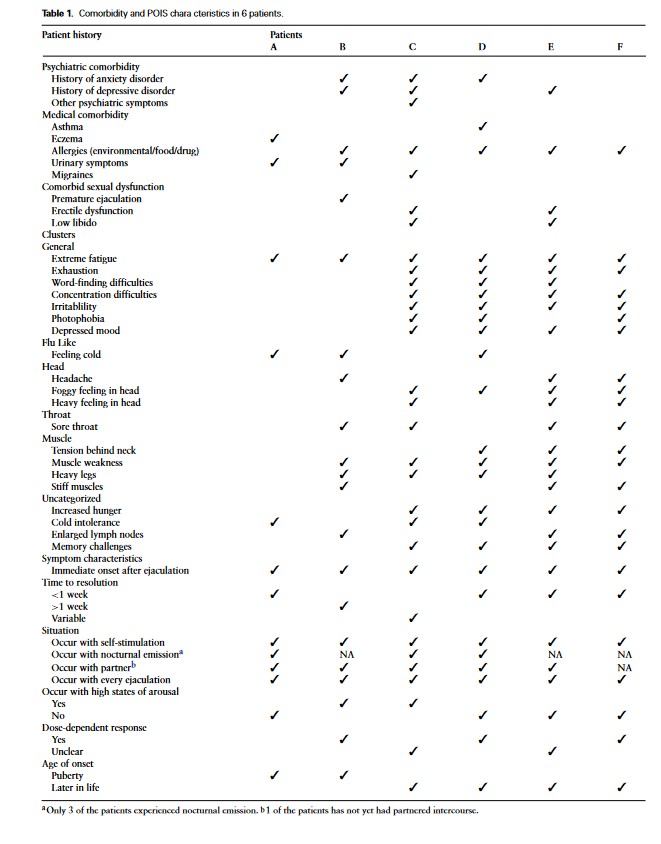POIS-Diagnosis
Postorgasmic-Illness-Syndrome Diagnosis

Diagnosis of Postorgasmic-Illness-Syndrome (POIS)
Postorgasmic-Illness-Syndrome (POIS) is a rare condition in which sufferers experience physical, cognitive, and psychological symptoms lasting from hours to days after ejaculation.
Diagnosis is challenging—there are no clear blood markers, the condition is little known, and is therefore often overlooked. In this article, you will learn everything about the current diagnostic criteria, how the diagnosis can be made, and what role the symptoms and symptom onset play.
Five Diagnostic criteria according to Waldinger
The classic POIS-Diagnosis is based on five criteria that were first defined by Marcel D. Waldinger in the early 2000s. Based on a study of 45 men, the following conditions apply12
1. symptoms: flu, fatigue, brain fog, depression
One or more of the following symptoms occur: Feeling of a flu-like state, extreme tiredness and fatigue, weak muscles, fever and heavy sweating, mood swings and easy irritability, memory difficulties, concentration problems, incoherent speech, stuffy or runny nose, burning eyes.
2. onset: Immediately
All symptoms occur within a few seconds, after a few minutes or within a few hours after ejaculation triggered by sexual intercourse, masturbation or spontaneously (e.g. nocturnal ejaculation).
3. frequency: almost always
Symptoms always or almost always occur, i.e. after 90% or more of all ejaculations.
4. duration: 2-7 days
Most symptoms last for about two to seven days.
5. recovery: rapid recovery
Symptoms disappear spontaneously.
If all five criteria are met, a classic POIS diagnosis is likely.
However, studies show that many affected individuals do not meet all requirements exactly, which makes diagnosis more complex.
Advanced diagnostics: Symptoms beyond “flu”
Recent case studies, such as those by Rosetti et al. (2023)3, expand the classic criteria to include additional symptoms:
- Hunger, sensitivity to cold, swollen lymph nodes
- Memory problems, mood swings, anxiety disorders
- Correlation with environmental allergies or psychiatric comorbidities (depression, anxiety disorders)
In their study of six men, Rosetti et al. also found evidence of symptoms developing solely as a result of sexual arousal. However, they found no evidence of an allergic reaction in the blood values.
This means that even if not every affected person shows classic flu symptoms, the diagnosis can be made if several of these additional symptoms occur consistently after every orgasm.
Diagnostic process: medical history, tests & clinical examination
A structured medical diagnosis includes:
1. Medical history and symptom diary
- A detailed history, including symptom duration, intensity, connections to sexual activity, and recurrence, forms the basis.
- Questionnaires and diary entries help to identify patterns.
2. Physical examination & laboratory values
- Blood tests to check hormone profiles (testosterone, etc.), inflammation or allergy values (e.g., IgE).
- Additional tests such as skin tests with the patient’s own ejaculate fluid can be useful—in individual cases, POIS has been “proven” in this way.
3. Differential diagnoses
- Prostatitis, hormonal disorders, and neurological diseases must be ruled out.
- This is the only way to make a specific diagnosis of POIS.
4. Specialist collaboration
- Ideally, the diagnosis is made by a team of urologists, endocrinologists, allergists, and psychologists.
- A multidisciplinary approach is essential, as POIS has complex physical and psychological effects.
Diagnosis duration & frequency often underestimated
POIS can occur as early as puberty with the first ejaculation (primary type POIS) or develop later in adulthood (secondary type POIS).
Studies show that diagnosis often takes years because doctors classify the symptoms as psychological or do not recognize them at all.
Conclusion: How to make a sound POIS-Diagnosis
- Check symptoms: General + extended complaints after orgasm.
- Document temporal patterns: Frequency, onset, duration.
- Blood tests & allergy screening: Hormonal and immunological analyses.
- Use a network of experts: Urology, immunology, psychology.
- Rule out other causes: e.g., prostatitis or neurological disorders.
POIS can only be diagnosed through careful testing—the first step toward targeted treatment and improved quality of life. If you regularly experience symptoms after orgasm, you may have POIS.
Our platform offers information, support, and a community of people facing similar challenges.
Get in touch with us: contact@pois-network.com
Extended diagnostic criteria according to Rosetti et al.4
The following table provides an overview of the expanded diagnostic markers and comorbidities identified by Rosetti et al. in six patients:
Three out of six patients had a history of depression or anxiety. Four patients suffered from environmental allergies, which is consistent with the results of other studies. No patient reported similar symptoms in the family. In all patients, symptoms occurred immediately after any ejaculation, be it nocturnal ejaculation or sexual stimulation by self or partner. In two men in the sample, the symptoms lasted longer than seven days.
The most common symptom clusters in the patient group were head, general and muscle symptoms, which, according to the authors, was consistent with findings in larger samples. All patients reported extreme fatigue after ejaculation, and five out of six reported muscle weakness. Three out of six described symptoms not mentioned in previous studies such as increased hunger, cold intolerance, enlarged lymph nodes and memory impairment.
Learn more about POIS-Treatment
United Against POIS.
- Marcel D. Waldinger, Marcus M.H.M. Meinardi, Aeilko H. Zwinderman, Dave H. Schweitzer, Postorgasmic Illness Syndrome (POIS) in 45 Dutch Caucasian Males: Clinical Characteristics and Evidence for an Immunogenic Pathogenesis (Part 1), The Journal of Sexual Medicine, Volume 8, Issue 4, April 2011, Pages 1164–1170. ↩︎
- Marcel D. Waldinger, Marcus M.H.M. Meinardi, Aeilko H. Zwinderman, Dave H. Schweitzer, Postorgasmic Illness Syndrome (POIS) in 45 Dutch Caucasian Males: Clinical Characteristics and Evidence for an Immunogenic Pathogenesis (Part 1), The Journal of Sexual Medicine, Volume 8, Issue 4, April 2011, Pages 1164–1170. ↩︎
- Leah Rosetti, Amin Kanani, Luke Witherspoon, Ryan Flannigan, Stacy Elliott, Case series: expanding diagnostic markers in postorgasmic illness syndrome, Sexual Medicine, Volume 11, Issue 2, April 2023, qfac021 ↩︎
- Ibid. ↩︎
- Ibid. ↩︎
